Archive for November, 2015
Day 1 of the Kalahari Augrabies Extreme Marathon – people dropping from the heat!
Posted by Jacqueline Windh in Africa, events, International, South Africa, ultramarathon on November 9, 2015
{This is my Kalahari ultramarathon report originally published on SleepMonsters. For an overview of what this one-week race is, check out my previous post] “This year will be the real race,” RD Estienne Arndt said to me at the start line. He was referring to last year’s KAEM, when racers didn’t get the full Kalahari Desert experience due to unseasonably cool temperatures and even a few days of rain. In contrast, today’s temperatures were predicted to sit around the mid 40s (well above 100 F), and those conditions are expected to hold for the entire week.

Dave and me at the start line.

And we’re off! Mostly dirt roads, but some cross-country.
It was already very hot as 70 of us set off from the start line at 9am. Starts for the rest of the week will be earlier. Today’s route was by far the easiest route of the week, though – only 25 km, with little elevation gain, rising 100 m over the first half then dropping 200 m over the second half. Those elevation changes may seem trivial to you, but out here in the sun they translate to serious issues of heat management. Even a tiny uphill raises your body temperature, so having the gentle downhill for the later (and hottest) part of the route was a very good thing.

The group is not too spread out yet. Many of us taking it very easy because of the heat.

Approaching our first aid station!
Aid stations were around 8 km apart, so there were two along the route before the finish. Dave and I had been advised to take this day as a training day, and to acclimatize, and we took that seriously. We were well down towards the back of the pack, but we managed ourselves really well. We made the first aid station in around 1:20, so managed to sustain a decent jog/walk pace. Shortly after, we passed a pair of guys from Austria, Josef and Ambros. Josef was obviously in trouble, having knee issues. As we approached the second aid station, Ambros caught up with us jogging, and told us that Josef had dropped out. Shortly after, we passed a 4WD with some of the medical crew, giving a woman an IV.
Less than 10% into this race, and already conditions were taking their toll.

We did run a bit – but mostly we took it very slow.
The route, however, was spectacular – in some places due to the starkness, wide open plains with a few sparsely scattered shrubs. In other areas, traversing rounded granite outcrops, winding our way through dry stream beds (soft sand and no wind, VERY hot but very pretty) and over bare rock hills. We were especially thrilled to see a herd of five giraffe a short distance from the track, less than an hour from the start.
Dave and I kept up our very conservative and relaxed pace. The heat was affecting Dave quite a bit, so we took our time at the second aid station, giving him a chance to cool down. The volunteers here are amazing, many them who have come back many times over the years.
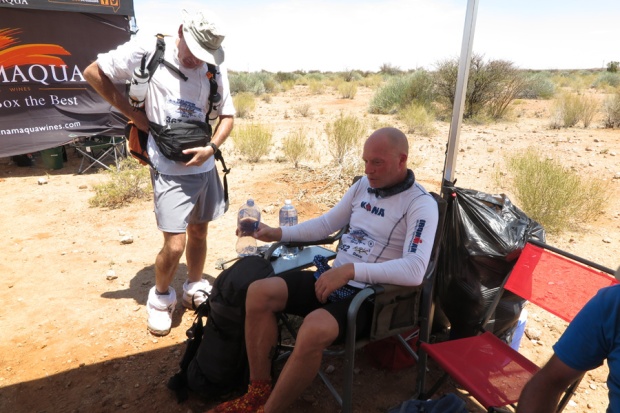
Dave is not looking his best.
It was noon when we left this aid station, and Dave was having a lot of trouble keeping his body temperature down, so we stopped a few times for him to try to cool down. It’s hard to find a good place to stop – the low hilltops had a good breeze but no shade, and the shrubby trees were located only in the dry river beds – stiflingly hot and sandy, and no breeze at all.

Nice scenery – when we remembered to enjoy it!

Dave wasn’t sure he would be able to finish the race at this point…
The last part of the route followed a very hot and narrow dry stream bed, enclosed by rock walls. We rounded a spectacular gap flanked by giant granite boulders, and there was Camp 1 set up – most of the field already here, relaxing in the shade in the gazebos. The temperature here in the shade was 48C, which means out there in the sun and on the hot sun it must have been well into the 50s.

Wejust rounded this boulder – and there was camp! Phew!
That heat definitely took its toll. I don’t have any final results or info, but I heard upon my arrival that 4 racers had pulled out so far. Ambros, in the next gazebo over from me, has been wailing with insufferable cramps, and got carted away by the medical crew for an IV. (Rules here are that you are allowed one IV – if you need a second, you are out).
Edward Chapman of the UK, here for his ninth time, was still well behind us. When he came in, after 6 hours on the course, he expressed concern for his friend Michelle. He had been feeling unwell and had stopped in the shade, so she should be ahead of him – but she had never arrived. Estienne immediately sent out a search crew. As I am writing this, Estienne has just returned to say that they found Michelle unconscious on the track several km out from here, so she also is out.

This is what camp looks like. And what we do here.
He has also informed us that the route will be altered tomorrow because of this heat. The distance will remain the same, but the section between CP2 and CP3 will be changed from “Death Valley” which has no vehicle access, to a more road-accessible route. As Estienne put it, if any other people drop from heat stroke, he needs to be able to get to them quickly by vehicle. I am really glad that they have such excellent safety procedures in place here – it was really clear to all of us today that the heat can kill very quickly, if you end up off track and run out of water.
Prepping for Kalaharai Augrabies Endurance Marathon – our first self-supported staged ultramarathon
Posted by Jacqueline Windh in Africa, events, International, races, South Africa, ultramarathon, wildlife on November 8, 2015
 In October, Dave and I raced the Kalahari Augrabies Extreme Marathon. The race is named for where it takes place: in Augrabies Falls National Park, in the Kalahari Desert, eastern South Africa along the border with Namibia. We’ve both raced multi-day staged ultramarathons before, but this would be our first self-supported race.
In October, Dave and I raced the Kalahari Augrabies Extreme Marathon. The race is named for where it takes place: in Augrabies Falls National Park, in the Kalahari Desert, eastern South Africa along the border with Namibia. We’ve both raced multi-day staged ultramarathons before, but this would be our first self-supported race.
 Self-supported means you must carry your own gear – in other words, carry a fairly heavy pack. In addition to the week’s worth of food, we also had to carry all of our clothing for the week (some racers opted for almost no clothing other than what they raced in – yuck!), sleeping bags and mats, and dishes. Race organizers provided hot water (so freeze-dried instant meals were the go) as well as canvas shelters for us to sleep under. Anything else was up to us.
Self-supported means you must carry your own gear – in other words, carry a fairly heavy pack. In addition to the week’s worth of food, we also had to carry all of our clothing for the week (some racers opted for almost no clothing other than what they raced in – yuck!), sleeping bags and mats, and dishes. Race organizers provided hot water (so freeze-dried instant meals were the go) as well as canvas shelters for us to sleep under. Anything else was up to us.
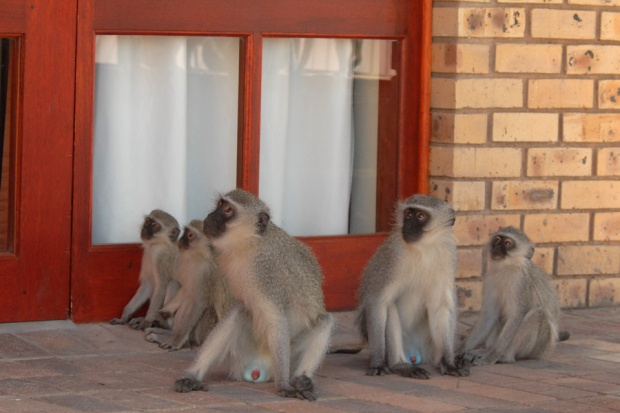
Monkeys showing their stuff. Yup,umm, those are what you think they are…

Cute little monkey family. (I think they are laughing at those boys).

This is the restaurant at Augrabies – frequented by colourful birds and these little dassies.
We were expecting heat – but by the week before the race, the forecast was looking scary! Day-time temperatures for race week forecast to hover around 40°C, or 105°F (and it ended up getting WAY hotter than that). We had been warned about very cold night-time temperatures here, so my husband Dave and I both brought our down jackets. Ha ha,that ended up being a joke.

Compulsory gear check – if we didn’t have all of the required gear, including at least 2000 calories of food per day, we were not allowed to race.
This year’s event had 71 racers entered, 34 of them from South Africa, and the remainder (just over half the field) coming from around the globe: elsewhere in Africa, the Middle East, a great number from Europe, three from Canada (including Dave and me) and one each from Australia and the USA.
Figuring out nutritional needs – packing enough, but not too much, not to mention the right balance of foods – was a challenge. I was carrying enough for close to 3000 calories per day, which ended up being more than I needed. However, I would rather err on that side, than go hungry at the end of a tough week in the Kalahari Desert!

Testing out our sand gaiters – some by ar.co.za and some by Rough Country. They velcro on to the bottoms of the shoes, to keep all sand out (major blister prevention strategy).
Some runners had their packs down to around 7 kg dry weight. Dave’sand mine both came down to 12 kg. We were okay with those weights starting out – not wanting to be missing stuff and suffering out there – but by the end of the race we both had learned so much that we would be able to go way lighter next time. Aid stations were 8-10 km apart, and we were provisioned with 1.5 l of water at each, so we would be carrying up to 1.5 kg of water on top of that dry weight.
Dave and I trained with our weighted packs for only a few weeks before the race. I think I would have been better training with the heavy pack a bit longer than that, as it does put a different type of strain on your joints and your feet – but overall, I was feeling pretty good pre-race.
Planned daily distances were: 25k, 30k, 40k, 80k (overnight stage), 47k, and 21k.

There were monkeys in our camp/race headquarters at Kalahari Augrabies National Park, and nice short walks to view the waterfalls and gorge. Dave and I went out on a two-hour game drive the afternoon before the race (I feel I should be resting – but I cannot resist seeing more of Africa and its wildlife, not to mention get an idea of the terrain we would be passing through). On the drive, we saw eland, springbok and a giraffe!
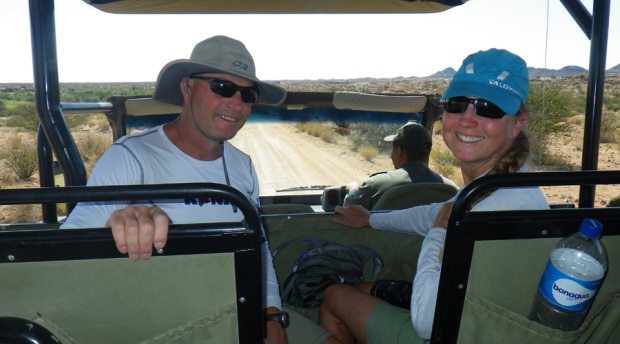
Heading out on our pre-race game drive.

A chance to get a look at the country we would be running through. Not a lot of shade.

Herd of eland.

A springbok.

Our first giraffe!

Another lovely view of the gorge.
Return to Stellenbosch – more wine-tasting!
Posted by Jacqueline Windh in Uncategorized on November 1, 2015
 Dave and I had enjoyed Stellenbosch so much on our way east, that we regretted having already booked our next night’s accommodation at Kleinbaai. But no worries! We hadn’t booked the next two nights, so we could easily turn around and come back through here again on our way back west, to Cape Town, so that’s what we did.
Dave and I had enjoyed Stellenbosch so much on our way east, that we regretted having already booked our next night’s accommodation at Kleinbaai. But no worries! We hadn’t booked the next two nights, so we could easily turn around and come back through here again on our way back west, to Cape Town, so that’s what we did.
On our first trip through, we hit a couple of wineries, then headed east to the coast via the Franszhoek mountain pass. This time, after our Gansbaai hike, we scootled back to Stellenbosch that afternoon via the scenic coast road. I had the whole trip precision-timed: how far we could go on the Gansbaai hike before having to turn around, and what time we needed to be back in the car and on the road, in order to make it back to Stellenbosch in time to visit one winery before they closed.
We already had a map of all of the wineries, and the owners at our previous accommodation had kindly circled the ones that they highly recommended. The one that (a) was on their recommended list and (b) was on our route into town and (c) would be open that day was Blaauklippen – so there we headed.
One of the many lovely things about the Stellenbosch wineries is that they are all so different. Wine-tasting here is a bit different from what I am used to in other parts of the world. You generally have to pay for tastings here – but then they are a more formal and drawn-out experience, where you sit down and have five different glasses poured for you, which you enjoy in a leisurely way, one by one. Do not plan on hitting four or eight wineries in a day!
Blaauklippen, like all of the wineries here, is in a stunningly beautiful setting – the vineyards backed by rocky mountains. The tasting area was a casual sitting area outside, and the staff were very friendly and knowledgeable.

Arriving at Blaauklippen.
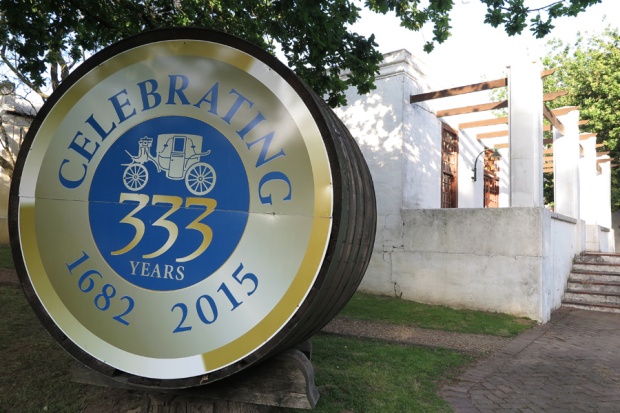
Such history in this part of South Africa – both here at Stellenbosch and at Constantia, it was amazing to visit wineries that are over three centuries old.
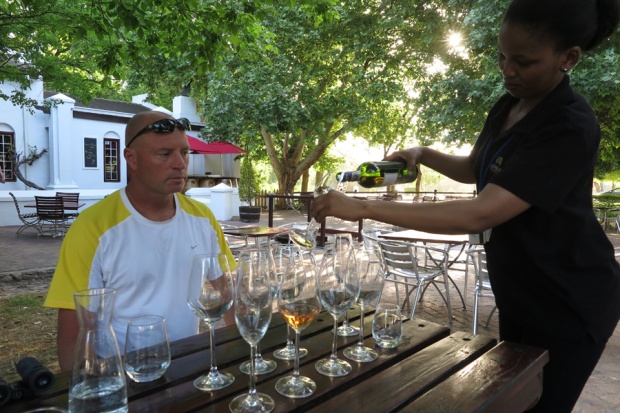
We each could choose a completely different selection of wines to taste – whites, rosés, reds and sparkling! (And then taste each other’s picks, too)
One of the other reasons that we had wanted to go back to Stellenbosch was because of its amazing “steakhouse” – the Hussar Grill – which takes such care of the meat, the waiters telling you how many days each of the cuts of beef has been hanging, and offering a great selection of wild African game meats there. The first time there I had kudu, which was exquisite – like the tenderest and tastiest beef you have ever had. This time Dave had ostrich. Another amazing night, enjoying great foods and very fine yet affordable wines (no plonk!).
The next morning, sadly, was our last here. We had a 2pm flight to Johannesburg, and from there, the next day we would be flying east to Upington, for our race in the Kalahari Desert. But the Cape Town airport is only about a half-hour drive from Stellenbosch… so we were able to get to one more winery before flying out. We selected Asara – with a more formal tasting room overlooking the wine barrel storage room (I am sure there is a better name for that…) which also doubles as a ballroom, with a fancy chandelier and space to lay out grand dining table down the central corridor.

The tasting room at Asara.

Wouldn’t you LOVE to attend a dinner here?

Well, at least we got to enjoy the wines here…

The grounds here were lovely too – and there is accommodation on-site.

Enjoying our last view of Stellenbosch, before whizzing off to catch our flight.